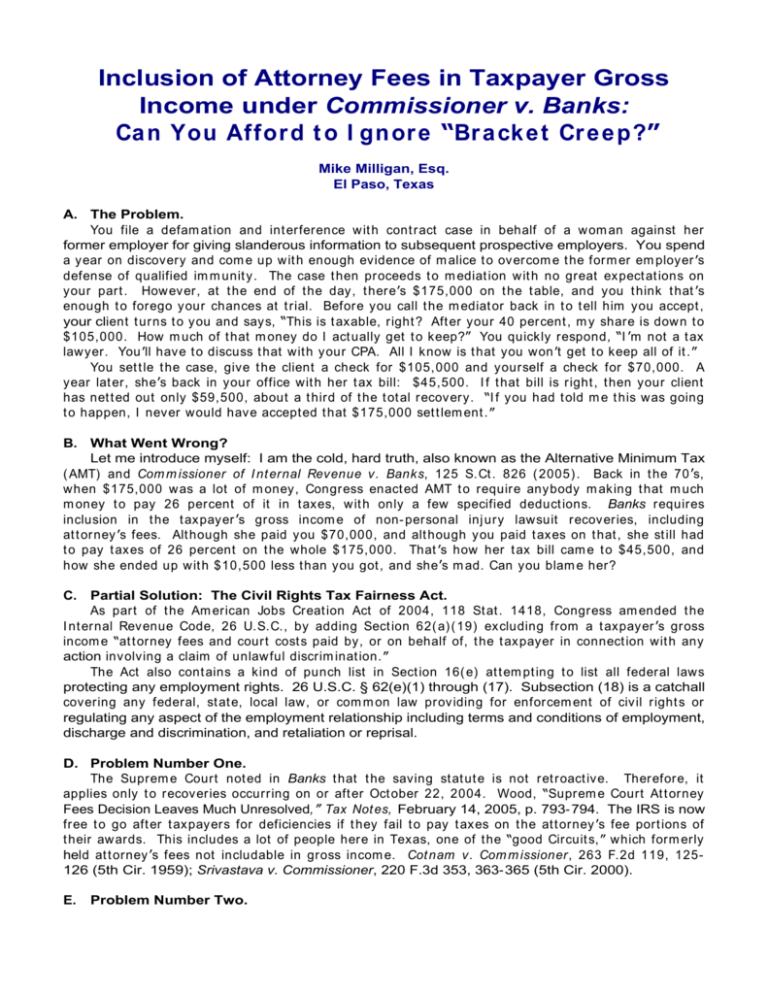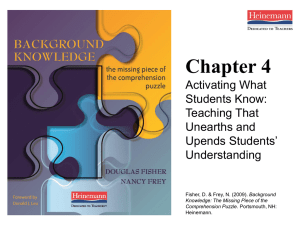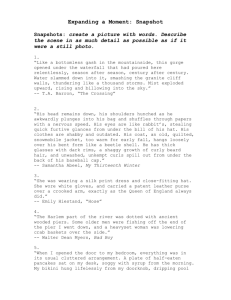Inclusion of Attorney Fees in Taxpayer Gross Income
advertisement

Inclusion of Attorney Fees in Taxpayer Gross Income under Commissioner v. Banks: Ca n You Affor d t o I gn or e Br a ck e t Cr e e p? Mike Milligan, Esq. El Paso, Texas A. The Problem. You file a defam at ion and int erference wit h cont ract case in behalf of a wom an against her former employer for giving slanderous information to subsequent prospective employers. You spend a year on discovery and com e up wit h enough evidence of m alice t o overcom e t he form er em ployer s defense of qualified im m unit y. The case t hen proceeds t o m ediat ion wit h no great expect at ions on your part . However, at t he end of t he day, t here s $175,000 on t he t able, and you t hink t hat s enough t o forego your chances at t rial. Before you call t he m ediat or back in t o t ell him you accept , your client t urns t o you and says, This is t axable, right ? Aft er your 40 percent , m y share is down t o $105,000. How m uch of t hat m oney do I act ually get t o keep? You quickly respond, I m not a t ax lawyer. You ll have t o discuss t hat wit h your CPA. All I know is t hat you won t get t o keep all of it . You set t le t he case, give t he client a check for $105,000 and yourself a check for $70,000. A year lat er, she s back in your office wit h her t ax bill: $45,500. I f t hat bill is right , t hen your client has net t ed out only $59,500, about a t hird of t he t ot al recovery. I f you had t old m e t his was going t o happen, I never would have accept ed t hat $175,000 set t lem ent . B. What Went Wrong? Let me introduce myself: I am the cold, hard truth, also known as the Alternative Minimum Tax ( AMT) and Com m issioner of I nt ernal Revenue v. Banks, 125 S.Ct . 826 ( 2005) . Back in t he 70 s, when $175,000 was a lot of m oney, Congress enact ed AMT t o require anybody m aking t hat m uch m oney t o pay 26 percent of it in t axes, wit h only a few specified deduct ions. Banks requires inclusion in t he t axpayer s gross incom e of non- personal inj ury lawsuit recoveries, including at t orney s fees. Alt hough she paid you $70,000, and alt hough you paid t axes on t hat , she st ill had t o pay t axes of 26 percent on t he whole $175,000. That s how her t ax bill cam e t o $45,500, and how she ended up wit h $10,500 less t han you got , and she s m ad. Can you blam e her? C. Partial Solution: The Civil Rights Tax Fairness Act. As part of t he Am erican Jobs Creat ion Act of 2004, 118 St at . 1418, Congress am ended t he I nt ernal Revenue Code, 26 U.S.C., by adding Sect ion 62( a) ( 19) excluding from a t axpayer s gross incom e at t orney fees and court cost s paid by, or on behalf of, t he t axpayer in connect ion wit h any action involving a claim of unlawful discrim inat ion. The Act also cont ains a kind of punch list in Sect ion 16( e) at t em pt ing t o list all federal laws protecting any employment rights. 26 U.S.C. § 62(e)(1) through (17). Subsection (18) is a catchall covering any federal, st at e, local law, or com m on law providing for enforcem ent of civil right s or regulating any aspect of the employment relationship including terms and conditions of employment, discharge and discrimination, and retaliation or reprisal. D. Problem Number One. The Suprem e Court not ed in Banks t hat t he saving st at ut e is not ret roact ive. Therefore, it applies only t o recoveries occurring on or aft er Oct ober 22, 2004. Wood, Suprem e Court At t orney Fees Decision Leaves Much Unresolved, Tax Not es, February 14, 2005, p. 793- 794. The IRS is now free t o go aft er t axpayers for deficiencies if t hey fail t o pay t axes on t he at t orney s fee port ions of t heir awards. This includes a lot of people here in Texas, one of t he good Circuit s, which form erly held at t orney s fees not includable in gross incom e. Cot nam v. Com m issioner, 263 F.2d 119, 125126 (5th Cir. 1959); Srivastava v. Commissioner, 220 F.3d 353, 363- 365 (5th Cir. 2000). E. Problem Number Two. A few claim s, som e of t hem em ploym ent relat ed, will be difficult t o pigeonhole int o t he I RS definit ion of em ploym ent discrim inat ion: defam at ion, false im prisonm ent , int ent ional or negligent inflict ion of em ot ional dist ress, and insurance bad fait h. Wood, supra, p. 795. Unfort unat ely, t hese em ploym ent t ort s are am ong t he m ost lucrat ive causes of act ion, since t hey are not subj ect t o any of the damage caps customarily found in employment discrimination statutes. F. 1. Possible Solutions. Effective Date of the Civil Rights Tax Relief Act. The Act applies t o j udgm ent s and set t lem ent s occurring aft er Oct ober 22, 2004. Wood, supra, p. 795. What does it m ean for a j udgm ent t o occur? I f it m eans t o becom e final, t hen j udgm ent s on appeal as of Oct ober 23, 2004, m ight not be considered t o have occurred. The safest way for a plaintiff to bring the case within the Act while the appeal is pending, however, is to settle it, because then the settlement occurs after the effective date of the Act. 2. Loopholes in the Banks Opinion. The t axpayers and t heir am ici proposed t hree alt ernat ive t heories for t he first t im e in t he Suprem e Court : ( a) t reat m ent of a cont ingent fee agreem ent as a Subchapt er K part nership under 26 U.S.C. §§ 702, 704, and 761; ( b) t reat t he cause of act ion as propert y and lit igat ion recovery as proceeds from disposit ion t hereof, so t he at t orney fees could be subt ract ed as a capit al expense under §§ 1001, 1012, and 1016 of t he Code; and ( c) t reat t he at t orney fees as deduct ible reimbursed employee business expenses under § 62(a)(2)(A). The Suprem e Court expressly declined t o consider t hose issues. Also, during oral argum ent , several of t he j ust ices, especially O Connor, raised concerns about const it ut ional quest ions arising from confiscatory taxation of money not actually received by the taxpayer. Wood, supra, p. 793. All of these might be fruitful areas for future appeals. The Court also expressed concerns about recoveries under fee- shift ing st at ut es, in language suggesting that it might revisit this issue with a proper set of facts: I n t he federal syst em st at ut ory fees are t ypically awarded by t he court under t he lodest ar approach, and t he plaint iff usually has lit t le cont rol over t he am ount awarded. Som et im es, as when t he plaint iff seeks only inj unct ive relief, or when t he st at ut e caps plaint iffs recoveries, or when for ot her reasons dam ages are subst ant ially less t han at t orney s fees, court awarded at t orney s fees can exceed plaint iff s m onet ary recovery. Treat ing t he fee award as incom e t o t he plaint iff in such cases, it is argued, can lead t o t he perverse result t hat t he plaint iff loses m oney by winning t he suit . Furt herm ore, it is urged t hat t reat ing st at ut ory fee awards as incom e t o plaint iffs would underm ine t he effect iveness of feeshift ing st at ut es in deput izing plaint iffs and t heir lawyers t o act as privat e at t orneys general. 125 S.Ct. at 834 [citations omitted]. However, t he Court found it unnecessary t o address t his issue, because t he plaint iff had set t led his claim for a gross am ount , wit h no court - ordered fee award or any indicat ion t hat t he cont ingent fee was paid in lieu of statutory fees. Id. The subj ect of fee shift ing is significant under Texas law, which has 265 fee- shift ing st at ut es. O Connor s Civil Pract ice & Rem edies Code Plus, ( Jones McClure Publishing 2004- 2005) , pp. 148163. I n any fee- shift ing case, t he set t lem ent should specify t he am ount of at t orney s fees, require separat e paym ent direct ly t o t he at t orney, and st at e t hat t he fees are in lieu of t hose provided by the applicable fee- shifting statute. 3. Flexibility of the IRS Definition of Unlawful Discrimination. Subsect ion ( e) ( 18) includes any st at ut ory or com m on law claim for t he enforcem ent of civil right s, or regulat ing any aspect of t he em ploym ent relat ionship. You can argue t hat freedom from defam at ion, false im prisonm ent , and inflict ion of em ot ional dist ress are all civil right s, and the common law prohibiting them regulates various aspects of the employment relationship. 4. Tell it to the Jury. Sect ion 18.091 of t he Civil Pract ice & Rem edies Code now provides, som ewhat inconsist ent ly, t hat t he j ury hear evidence of net loss aft er t axes and t hat t he court inst ruct whet her t he recover is t axable. I f you put on an expert ( usually one of your friends will oblige) t o t est ify about t he Banks decision, you can t hen argue t hat t he j ury needs t o give t he plaint iff m ore m oney t o m ake him whole. G. Further Reading. Robert W. Wood, Taxat ion of Dam age Awards and Set t lem ent Paym ent s, Third Edit ion ( 2005) , published by Tax I nst it ut e, 639 Front St reet , 2nd Floor, San Francisco, CA 94111, fax 415- 8341888, email info@taxinstitute.com. [Author receives no consideration for this promotion.]





